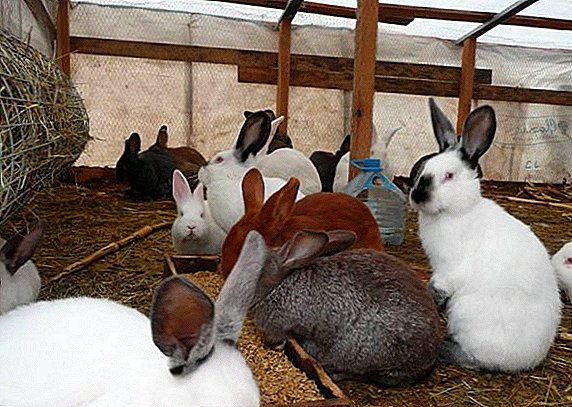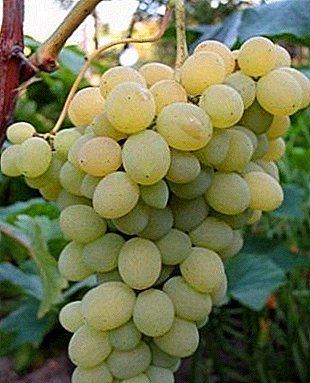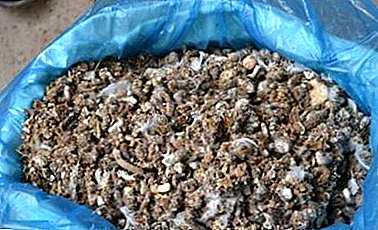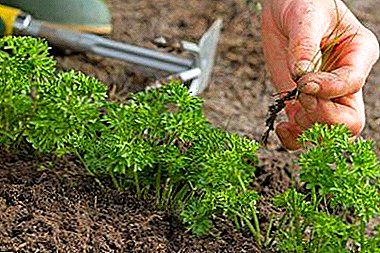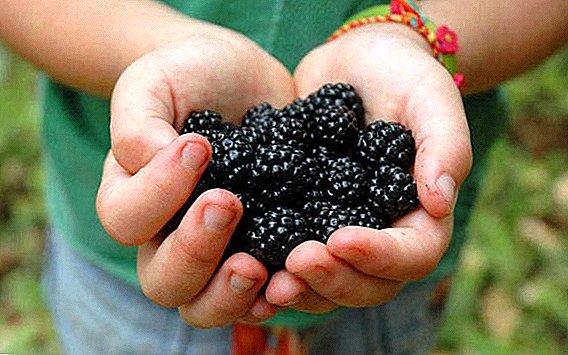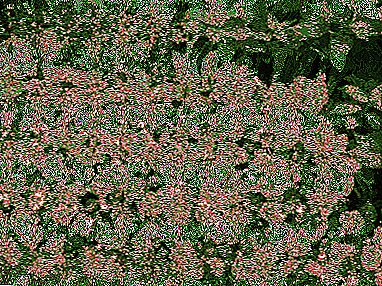
Garden balsam - one of the most beautiful representatives of the flora. Bright, colorful, unpretentious, it became a wonderful decoration of many land plots.
This plant does not take away from its owner a lot of time and effort, if you know the simple requirements and rules for care.
About them will be described in detail in this article. You will also learn about the origin of this plant and its main varieties.
In addition, there will be photos of this beautiful flower, so you can enjoy its beauty.
Botanical description
Garden balsam - is a grassy flower, a representative of the genus Impatiens. If you translate this flower into Latin, you get "impatient". As a rule, it blooms in summer until August, when the fruits appear. Boxes of fruit are twisted when they bloom, and small seeds fall to the ground. They jump out in different directions up to two meters in diameter.
Garden Balsam is a poisonous plantThis is worth considering if children often play on the ground and animals run around.
History of
 This flower was brought to Europe in the 16th century. He lived in the tropical forests of Africa, on its eastern shores. Also, the plant can be found in India, England and Ukraine. At first, decorative varieties specially grown for pots were especially popular.
This flower was brought to Europe in the 16th century. He lived in the tropical forests of Africa, on its eastern shores. Also, the plant can be found in India, England and Ukraine. At first, decorative varieties specially grown for pots were especially popular.
Later, people got acquainted with street types of balsam, which got accustomed to land plots and received its local name - Wet Vanka. This name appeared due to the observation of balsamine. Flower growers noticed that with increased humidity, droplets of water are formed along the edges of the leaves. This liquid is secreted by the plant itself. Now balsam is very common throughout our country, especially in western and eastern Siberia.
Appearance and characteristics
Garden Balsam is very fragile. It has fibrous roots and a bright green, sometimes purple sprawling crown. Oblong leaves with small teeth that grow up to 10 cm long make the plant beautiful even in the absence of flowers. Straight dark stem has many branches. Bright, mostly red and yellow inflorescences with medium size, have an irregular shape. A long spout forms in the middle of the flower.
Hybrid varieties have a large variety of species and color palette. To date, experts represent about 400 species of this beautiful plant. There are dwarf species, and there are plants with sizes up to 120 cm.
What is the difference between outdoor impatiens and room?
Distinguishing garden balsam from household relatives at first glance is simple. There is no need for special knowledge. It grows on the street and has a more loose, like a transparent bush. This becomes especially noticeable if the plant gets ultraviolet light. Garden varieties bloom mostly in shades of yellow, while indoor varieties have a huge variety of colors.
It is believed that street varieties have medicinal properties.. Garden balsam is widely used in traditional medicine and helps to cope with many ailments. Bulky fleshy parts of leaflets contain ascorbic acid, a lot of organic substances and flavonoids - substances of plant origin with antioxidant properties. In home varieties such features not.
Another important difference from the home balsam from home is that the first flower is an annual. But its beauty and the flowers scattering around the crown compensate for this lack in full.
Varieties and photos of a herbaceous plant
Of the 400 species of garden balsam, some species are very popular.
Waller flower
When flowering in balsam Waller is almost invisible leaves, and inflorescences cover almost the entire surface of the plant. The most common varieties of this type of garden balsam: Stardust, Candy, Duet, Symphony.

Perennial hybrid: New Guinea
The New Guinea Balsam is a perennial hybrid resulting from the selection of some species. So far there are no seeds of this plant species in our country. But he also has his own varieties: Java, Macarena, Mini Gini, Jungle Rain.
Non-decorative plants of this species: Iron-Nose, Ordinary, Small-flowered, Balfour, Niamiamsky.

Undersized
The short look of balsam grows no higher than 15 cm. Dense collections of flowers are so abundant that they make the plant look like a single bouquet. Differs from its counterparts in a rich variety of shapes and colors. Low-growing balsam blooms until the autumn frosts.

Features of landing in an open ground
If the florist wants to plant balsam on a plot of land in the garden, he should know some rules for growing and caring for the plant. To do this, choose a place where there are scattered rays of the sun and a lot of shadow. Such a place may be under a large tree crown, near the western wall of the house. The best time to plant is early spring. When the frosts have already gone, and the temperature does not drop below at least 5 degrees. Young plants can die at zero.
After planting it is better not to immediately add any fertilizer to the soil. or dressings. The plant must adapt to new conditions and after two weeks, you can add some nutrients.
The best place for planting will be the lakeside garden pool. Or maybe there is some source on the plot or a live open fountain. The plant loves moisture. Such a place would be ideal for its growth.
Lighting and place flower beds in the garden
The most suitable place for planting this beautiful plant will be a shaded place. The direct rays of the sun can ruin a flower. Ultraviolet burns leaves, leaving terrible burns on them. The moisture-loving plant dries out before our eyes. Some light is allowed by protecting the branches of trees or larger plants nearby. Well, if there is a river or any other body of water. This will simplify watering, because it is necessary for balsamine very often.
Soil requirements
The best option would be loose, wet and weak acid soil. For landing balsam need to prepare a mixture of sand, peat and humus. It will be good to add leaf soil. The top layer of the earth should always contain moisture, this suggests that you need to water the plant carefully.
Rules for the care of balsamic bush
Garden Balsam perfectly adapts to many conditions.. His departure, in fact, consists only in abundant watering and removal of unwanted weeds that can survive the plant. In addition, regular weeding helps the soil to remain loose and crumbly. So, the root system breathes and develops perfectly. If summer days are especially hot, watering should be done every evening. This should be done sufficiently abundantly to properly shed the soil to 30-40 cm deep.
Fertilizing balsam is useful substances rich in nitrogen and phosphorus. With a lack of these substances, the foliage fades, inflorescences become smaller, and various diseases appear.
Common diseases and pests
 Like any living plant, a balsam also has its weaknesses and susceptibility to various parasites.
Like any living plant, a balsam also has its weaknesses and susceptibility to various parasites.
- Rot. These phytopathogenic fungi and bacteria infect balsam leaves if watering occurs too hard and there is stagnation of water. Drainage of soil will be the solution to this problem.
- Spider mite. He sucks the juice from the plant, and it fades in a matter of days. Here will help the soap solution, which need to spray the flower from the spray. Chemical compositions are used only in extreme advanced cases.
- Viruses. Understand that the plant is infected with special viruses can twist the leaves. Yellow spots appear on the surface of the flower. Usually the cause of the virus is the presence of aphids. And with it you need to fight only chemical special means.
Annual plants, such as balsam, after flowering are completely removed from the soil. So, the chances of developing diseases and pests are reduced to a minimum. Such prophylaxis will prevent the recurrence of infections in the next landing.
There are diseases that affect the plant. Here are some of the most common diseases.
- Leaves fall due to hypothermia or lack of light. The same problem may be with excessive dryness of the soil.
- Buds fall, as there was overdrying of the soil or incorrect, rigid adaptation of the plant during transplantation.
- Stretched stems due to lack of light.
- Weak flowering, inflorescences are rare, because they lack nutrients and additional nutrition.
With proper care, this plant does not take much trouble and will delight in its health, beauty and pomp.
Why does not bloom?
It also happens that in appearance a healthy and beautiful plant, not susceptible to pests and having no signs of disease, does not bloom. So even with perfect care, something went wrong. It is important to find out the cause and eliminate it. The reasons may be a lack or excess of light, irrigation, microelements, temperature changes and much more. All of this has already been said above, and if all the conditions are met, then there is one more spare advice on the subject of balsam flowering.
Balsam need time to cut and remove old, overgrown and too large shoots. This is necessary for the formation of new fresh twigs, which will begin to give abundant flowering.
Breeding methods
Plant balsam can be in two main ways.
Seeds
 Seeds need to be collected when the fruits are ripe.
Seeds need to be collected when the fruits are ripe.- Plant seeds in shallow containers or boxes.
- Pour a thin layer of earth on top and pour water over it.
- Capacity can be covered with foil, such a greenhouse will allow shoots to germinate faster.
- Greenhouses are best placed in a dark and warm place.
- When the first sprouts seem, you need to rearrange the flower on the bright window sill.
- Watering occurs frequently, but stagnation of water can not be allowed.
- Days after 20 starts transplanting babies in separate pots. For this perfect disposable cups.
- Seedlings are fertilized and become stronger.
- It is time to temper the plants and adapt them to the weather conditions of the environment. To do this, you need to more often take them outside to a shaded place with scattered rays of the sun. At night, it is better to return home.
- As soon as about 10 leaves appear on the seedlings, you can proceed to transplanting them to garden soil.
- Pour water into the hole and root the balsam to the level of the first leaves.
Seeds sown in January will give flowering bushes in May.
Bushes
- Dig up a ready-to-use shrub 10-15 cm high. It is very important to leave a lot of ground on the roots so as not to break them too.
- In the hole, a depth of 20 cm. Pour water and place the balsam on the bottom, gently covered with earth.
- In order for bushes to take root as best and faster as possible, a good option would be to take a ground from the place where they were moved from. Such land should be mixed with the land in the garden. This will help avoid the stress caused by a dramatic change in soil composition.
Balsam like land of weak acidity. And such a soil give impurities peat.
Garden balsam combines a lot of beauty: beauty, benefits, healing properties. Such a flower will delight all summer and will be a source of aesthetic pleasure for the whole family.


 Seeds need to be collected when the fruits are ripe.
Seeds need to be collected when the fruits are ripe.